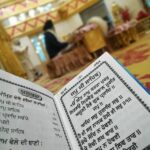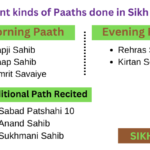Akhand Path (Punjabi: ਅਖੰਡ ਪਾਠ, Punjabi pronunciation: [əkʰəɳɖᵊ paːʈʱ]) The continuous and uninterrupted repetition of Sri Guru Guru Granth Sahib Ji is known as the Akhand Path Sahib].
Sikhism
The continuous repetition of all verses in the Guru Granth Sahib from beginning to end, in 31 Raga as specified, in all 1430 pages, takes more than 48 hours per group of students. Nearby, on top of a bowl of water, the coconut is kept wrapped in saffron or white cloth. of the recital. During the study it is customary for langar (or public food) to be available at all times, thus requiring continued service and dedication of those esteemed by the Akhand Path. By definition, gurdwara is a space appropriately dedicated to accepting and placing Sikh texts. The Gurdwaras play an important traditional role in the Sikh community, as they provide food and rest for all visitors, and thus become. The Holy Book [i.e.] Guru, “a practice known as Akhand Path, which lasts for about two full days and a whole night.
Some Gurdwara holds a weekly Akhand Path and this gives the church (Sadh Sangat) a good opportunity to establish a close relationship with the Guru – Grant and a fellowship that offers the opportunity to do volunteer work (Seva) thus blessing the Guru Granth Sahib for the whole meal.
It is said that when Guru Gobind Singh finished writing the Guru Granth Sahib, he had five members of the congregation (Sadh Sangat) who sang the completed Grant to him incessantly, for more than two days and nights. He stood there and listened to the whole Guru Granth Sahib without sleep. The people bring water for him to bathe and his food to stand. This was the first Akhand Path. Akhand’s second route was to Nanded after Guru Gobind Singh sent Banda Singh Bahadur to Punjab. The Akhand Pathees (Granth repeaters) were Bhai Gurbaksh Singh, Father Deep Singh, Bhai Dharam Singh (of Panj Piaray), Bhai Santokh Singh, and Bhai Hari Singh (who used to write the daily diary of Guru Gobind Singh). Before handing over the Guruship to the Guru Granth Sahib (then known as Adi Granth) Guru held the Akhand Path and proclaimed Adi Granth as the eternal Guru of Sikhs.
Following this example, the Sikhs developed a tradition of dedicating Akhand Methods to various functions. Before the wars, the Sikhs listened to the Akhand Path and prepared for battle. The Akhand Path was organized before the Sikhs came out to rescue 18,000 indigenous women who had been captured by the Moghuls and taken as slaves.

In 1742, when the Sikhs were in the forests of Punjab, another Sikh warrior named Bibi Sundari, asked shortly before her death (because of the war wounds,) to arrange for the Akhand Path. He lay there near the Guru Granth Sahib and listened to the full repetition of the Way. After the kirtan, Ardas and Hukam, found Karah Prashad, “Waheguru ji ka Khalsa, Waheguru ji ki Fateh” breathed his last. Thus began the tradition of giving the Akhand Path within 48 hours.
If the Akhand Path is to be fetched from Gurmukhi, it must be completed within 48 hours, with no recurrence of 31 Ragas as specified. If done in English, it will take more than 72 hours to complete.
During the Akhand Path, when Hukam is taken at the end of the program, Pathee (a Path student) reads the Gurbani they came to during the study. They may slow down and read it. In this case, the first two and last lines are not repeated. When the Pathees reached the end of Hukam, they continued to study the Akhand Path.
The Akhand Path should be read aloud, clearly, and correctly
It is imperative for all people, who listen to the Route, to be able to understand the verses being spoken. However, such people (Sikhs) are rarely found who understand all the verses of Gugu Granth Sahib, written in ancient Gurumukhi text in various languages - including Lehndi Punjabi, Braj Bhasha, Khariboli, Sanskrit, and Persian – in general. compiled under the general heading of Sant Bhasha.
Sadharan Paath
Sahej Paath or Sadharan Paath or “Khula Paath” literally means simple or easy repetition. It is a process (duplication) that can begin and end at any time; with as many or as few participants as you wish. The recitation of the Guru Granth Sahib begins at the beginning of the Grant Sahib and all 1430 pages of the Guru Granth are read slowly from seven days too, in some cases, within a few months. Slow and unconventional, unhurried reading of the whole Guru Granth Sahib.
It is a good time to practice pronunciation and to read the meanings. One can also listen and correct the student during the repetition. Anyone can do his Sahej Paath. This is how a beginner usually does the first few Paaths at Guru Granth Sahib.
The Sikhism code of conduct encourages all Sikhs to develop a daily reading habit devoted to scripture so that eventually the whole text is read from beginning to end. The Sadharan route is read aloud from only one volume of the Guru Granth Sahib by one person or group at any given time.
The Sadharan paath may be recited during birth, marriage, or death, by family members for one or two weeks.
One can learn the way of Sadharan within a few months, or even years, depending on the time available and skill.
Reading 20 Ang daily it is possible to complete the Sadharan Paath in about 10 weeks.
Learning the four daily Sadharan Ang methods can be completed in a year.
Sahej paath, or simple reading, can be recited without interruption or occasionally and completed by one person or group. Since there is no restricted method, many students may choose to study as a group in any language from the multi-volume Guru Granth Sahib Translations so that participants who can read Gurmukhi can join the experience of the team effort required to complete it. reading the text.
At an average of 20 pages per hour, it takes approximately 72 hours without interruption to fully read the eight-volume Manmohan Singh’s Steeks in English as a transliteration of one Romanized phonetic translation of one of Gurmukhi Ang requires approximately 3 English pages printed. Roles are properly assigned and saved on the registration sheet.








